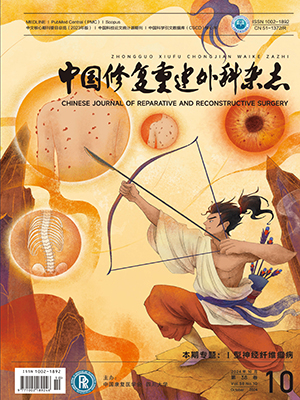Objective To provide the anatomic evidences and the choice of tendon graft for anatomic reconstruction of posterolateral complex through the morphological and biomechanical study on posterolateral structures of the knee in normal adult cadavers. Methods Twenty-three fresh lower l imb specimens from voluntary donators and 9 lower l imbs soaked by Formal in were selected for anatomic study on the posterolateral complex of the knee. Six fresh specimens were appl ied to measure the maximum load, intensity of popl iteus tendon, lateral collateral l igament, and popl iteofibular l igament, which were key components of the posterolateral complex. Results Popl iteus musculotendinous junction was located at 7.02-11.52 mm beneath lateral tibial plateau and 8.22-13.94 mm medially to fibular styloid process. The distances from femoral insertion of popl iteus tendon to the lower border of femoral condyle and to posterior edge of femoral condyle were 10.52-14.38 mm and 14.24-26.18 mm, respectively. Popl iteofibular l igament originated from popl iteus musculotendinous junction and ended at fibular styloid process. Lateral collateral l igament was located at 10.54-16.48 mm inferior to fibular styloid process, and the distances from femoral insertion to the lower border of femoral condyle and to posterior edge of femoral condyle were 14.92-19.62 mm and 14.66-27.08 mm, respectively. The maximum load and intensity were 579.60-888.40 N and 20.50-43.70 MPa for popl iteus tendon, were 673.80-1 003.20 N and 24.30-56.40 MPa for lateral collateral l igament, and were 101.56-567.35 N and 8.94-36.16 MPa for popl iteofibular l igament, respectively. Conclusion During anatomical reconstruction of posterolateral complex, the bony tunnel of the key components should be located according to the insertion mentioned above. On the basis of this study, the maximum load and intensity of selectable grafts should exceed 833 N and 36 MPa.
Citation: YE Junwu,LI Jian. APPLIED ANATOMIC AND BIOMECHANICAL STUDY ON RECONSTRUCTION OF POSTEROLATERAL COMPLEX OF KNEE. Chinese Journal of Reparative and Reconstructive Surgery, 2010, 24(10): 1199-1203. doi: Copy




